There are two ways to eat melon: at the beginning of a meal as an hors d’oeuvre or starter for savory dishes or at the end as a dessert fruit.
The high water content of melons makes them refreshing, especially during hot summer weather, but because they are so high in water content they are not suitable for cooking.
Chill melons in the refrigerator or a tub of ice water. Cut them into crescents and enjoy!
Favorite melon recipe
See all the serving suggestions below.
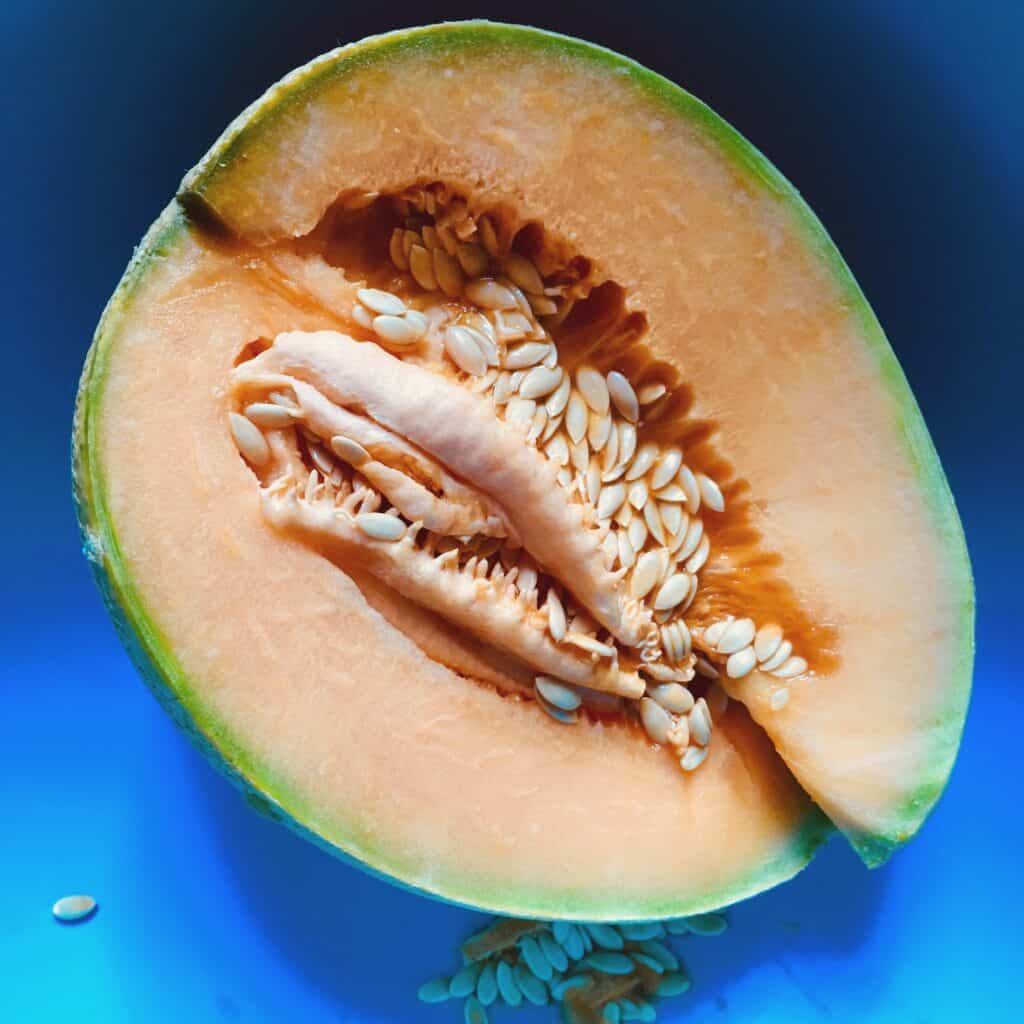
Summer and winter melons
Seasonally, melons are divided into two categories: the summer melon and the late or winter melon.
- Summer melons include varieties of muskmelon (which in North America are known as the cantaloupes—with their yellow-tan netted rinds) and varieties of true cantaloupe, with their smooth rinds. Summer melons come to harvest at the end of summer and are sometimes called short-season melons since they are ready for harvest just three months after planting.
- Winter or late melons include varieties of casaba and honeydew melons and the Crenshaw melon. These melons often take a month or longer than summer melons to ripen and so come to harvest in late autumn or early winter in most regions. Winter or late melons also are referred to as long-season melons. Late-ripening winter melons can be stored longer than other types, some into the winter months. In fact, some winter or late melons prefer a period of cool weather to ripen properly. Winter melons generally lack the musky odor of muskmelons.
Kitchen Helpers from Amazon:
- Oster Vegetable Steamer
- Chef’s Knives Set of 6
- EZ Off Jar Opener for Weak Hands
- Pepper Core Remover Stainless Steel
- Kitchen Utensils – Set of 35
Types of summer and winter melons

Muskmelon: round, yellow-tan netted rind with salmon, white, or green flesh weighing about 2 to 3 pounds (.9-1.3 kg). Very sweet taste and aromatically perfumed flesh. Muskmelons are also called netted or nutmeg melons and are the principal commercial melons grown in the United States. Most muskmelons are ripe when the stem begins to separate or “slip” from the fruit.
True Cantaloupe: oval or globe-shaped with hard, rough, scaled or warted-rinds (not a netted skin) with gray-green, yellow-tan and orange, or salmon-orange flesh weighing about 2 pounds (.9 kg). Sweet tasting and aromatic. True cantaloupes are considered the best flavored of all melons. Many of these melons have been traditionally grown in France and take the names of French regions or towns, Cavaillon, Charantais, and Touraine. Generally, these melons do not “slip” from the vine but must be cut when ripe. True cantaloupes are also called rockmelons.
Casaba: round or ovoid with wrinkled, rough yellow-rind and greenish-whitish flesh weighing about 5 pounds (2.2 kg). Greenish tinge at the stem end. Smooth-textured, creamy flesh is juicy and subtly sweet, and less fragrant than other melons. Casaba winter melon varieties, unlike the honeydew winter melon varieties, are smooth-skinned. The name of the casaba is derived from the town of Kassabah near Smyrna (now Izmir), Turkey. Two well-known varieties of casaba melons are the Persian melon and the Santa Claus or Christmas melon. The Christmas melon is so late-ripening that it is often served at late-year holiday meals in place of other melons which may be out-of-season.
Honeydew: more ovoid than round with smooth rind that changes from pale green to creamy yellow as it ripens weighing about 3 pounds (1.3 kg); green, white, orange, or pink-orange flesh. Very sweet and juicy with a melt-in-your-mouth texture. The smooth-skinned honeydew melon that we know today was named in 1915 and is thought to be identical to the French cultivar, White Antibes. However, honeydew type melons have been around much longer and were favored by the ancient Egyptians thousands of years ago and before that by the ancient Persians.
Crenshaw: oval, smooth yellow-green skin with pale green or salmon flesh weighing about 6 pounds (2.7 kg). A hybrid cross between the casaba and cantaloupe. The flesh is extra sweet and juicy with a sweet-spicy aroma. Softer than other melons. The Crenshaw winter melon is a hybrid muskmelon, a cross between a casaba and a Persian melon. The Crenshaw is notable because it is considered one of the sweetest and most succulent of melons.
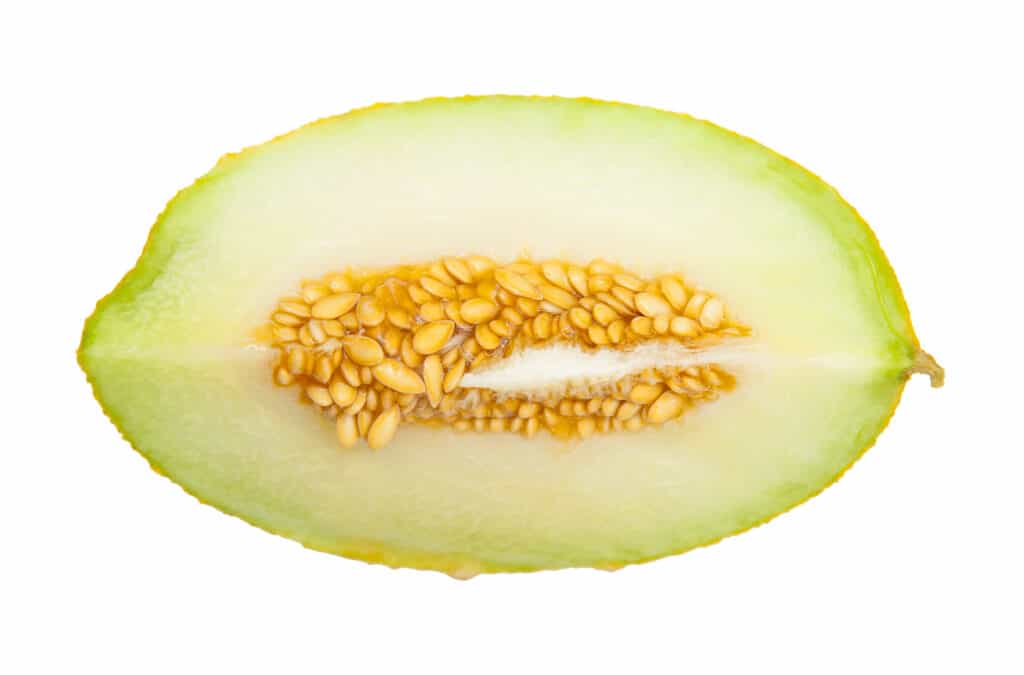
Choosing melons by ripeness
- Select melons with a sweet aroma and whose stems have turned brown. Gently press your thumb between the fruit and the base of the stem; if the stem parts away easily, the melon is ripe.
- A ripe melon will offer a hollow sound when tapped with the palm of the hand. Select melons that are heavy for their size and free of bruises or soft or damp spots. Avoid overly soft melons or those with a strong odor or unusual color.
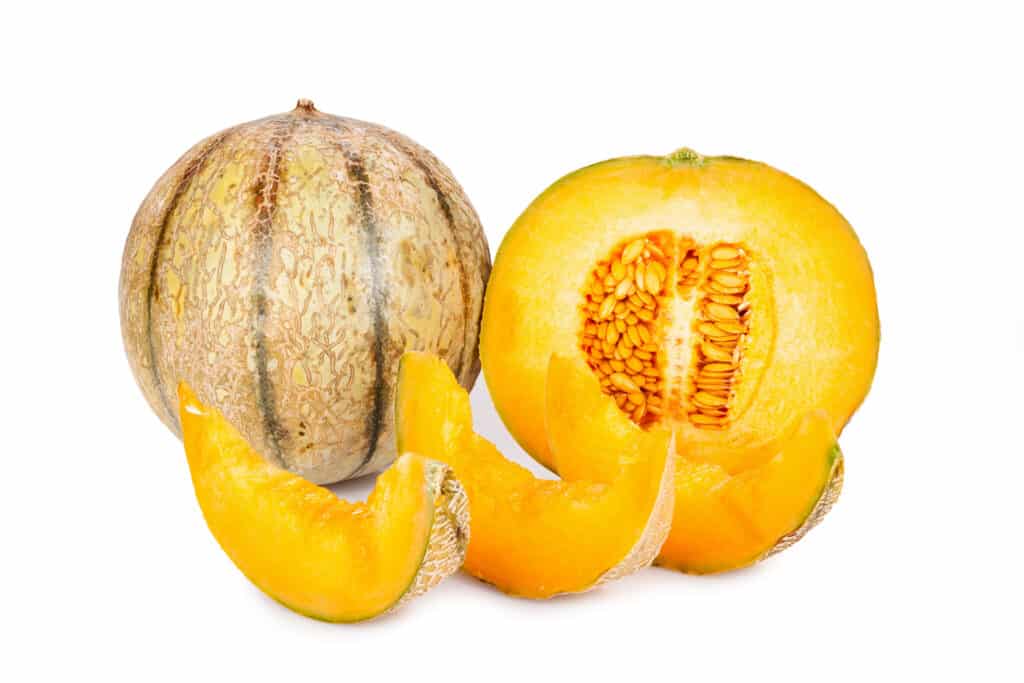
Winter melon selection
Honeydew, casaba, and Cavaillon melons are classed as winter melons because they ripen more slowly than other melons and are usually not ready until late fall. After harvest, they even continue to ripen in storage.
Honeydews should have a smooth, evenly yellow rind that is slightly green at the stem end. Look for honeydews that are oval or elongated. Casabas have rough green or green and yellow skin. Cavaillons are slightly elongated with a finely ribbed rind. Some believe they are the tastiest of this group.
Serve. Season winter melon slices with salt and freshly ground pepper.
Melon ripeness guide
- Cantaloupes are ripe when they slip easily from the stem.
- Casaba and Honeydew melons are ripe when the skins turn from greenish-white to yellowish-white and feel slightly sticky. A slight aroma will emanate from the blossom end when ripe.
- Crenshaw and Persian melons are ripe when they develop a fruity scent.
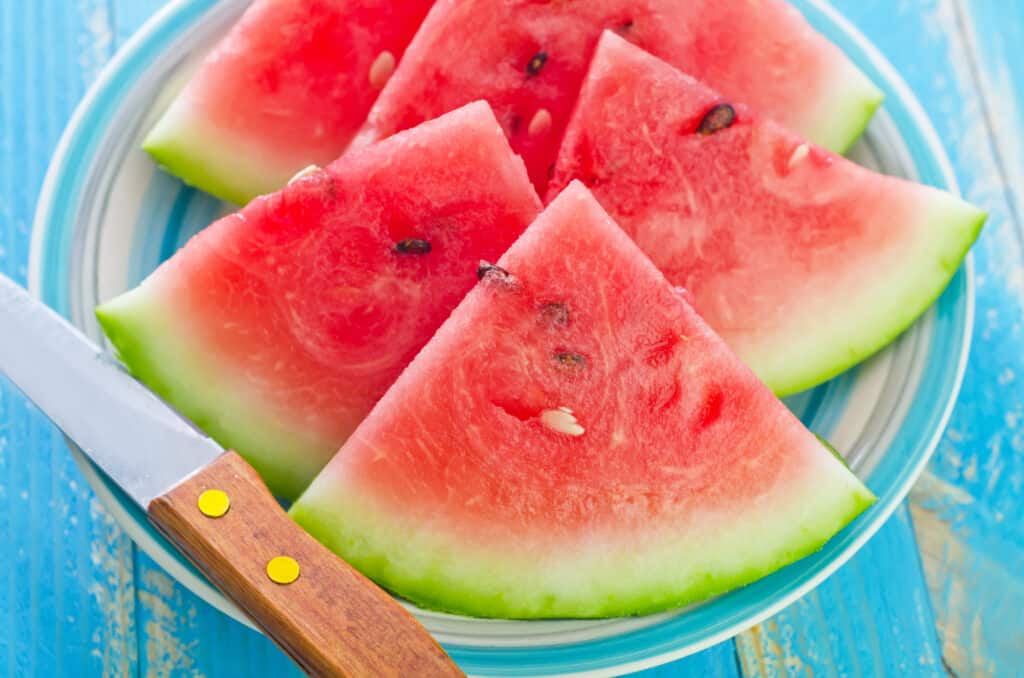
How to store melons
- Melons will keep in the refrigerator for 2 to 4 weeks. Some sweetness and flavor will be lost after a few days.
- Following harvest, cantaloupes should be cooled as rapidly as possible to about 50°F (10ºC). Cooling rapidly decreases the respiration rate and loss of sugars.
- Keep ripe melons in the refrigerator but wrap them in plastic so that other foods do not absorb their odor. Melons produce ethylene gas which hastens the ripening of other fruits and alters the flavor of other foods.
- For maximum flavor, take the melons out of the refrigerator shortly before serving.
- An unripe melon can be kept at room temperature until it has a delicate aroma.
- Melon balls can be frozen and served later.
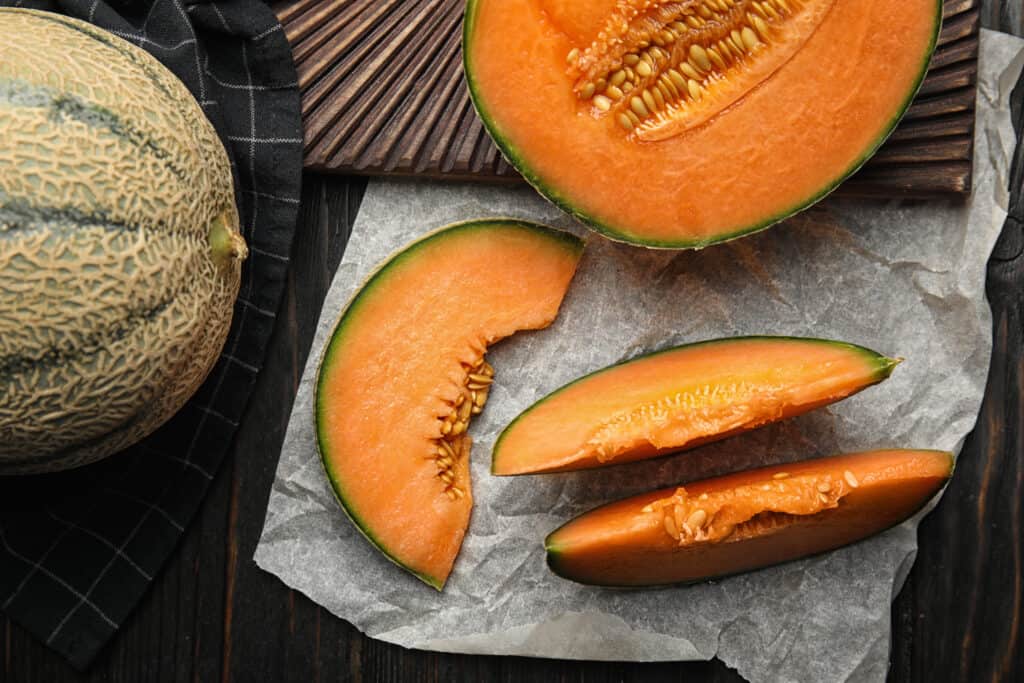
How to prepare melons
- Cut melon into quarters or halves, scoop out the seeds of the portion you intend to use, and leave the seeds in any unused portion to keep it from drying out.
- Serve melon cut into slices or cubes or scoop out the flesh with a melon baller.

Ways to serve summer and winter melons
- Melons can be served alone as a snack or at the beginning or after a meal.
- Use melon to accompany meat, poultry, and seafood, and add to vegetable salads, rice salads, and chicken salads.
- Serve melon with ham, deli meats, prosciutto, dried meats, smoked fish, or cheese.
- Blend diced melon with lime and mint to make cold melon soup.
- Fill melon halves with sweet wine to serve as an appetizer.
- Add diced melon to salsa.
- Add melon to cereals and fruit salads.
- Mix balls or chunks of different types of melon for a dessert dish.
- Top melon halves or wedges with scoops of yogurt or ice cream.
- Juice or purée melon and use to flavor sorbets or ice cream.
- Use melon rinds to make melon preserves, chutneys, and sweet pickles.
- As a starter, melon can be seasoned with salt and freshly ground pepper or with ginger. As a dessert, melon can be sprinkled with superfine sugar or as many would have it simply plain
- Using a squeeze of lemon or lime juice will bring out the flavor. Also flavor melon with ginger or sherry.
- The melon should be eaten with a fork, not a spoon. You see, the back of a cold spoon anesthetizes the taste buds. When that happens, half the melon’s flavor is lost. So enjoy your melon with a fork.
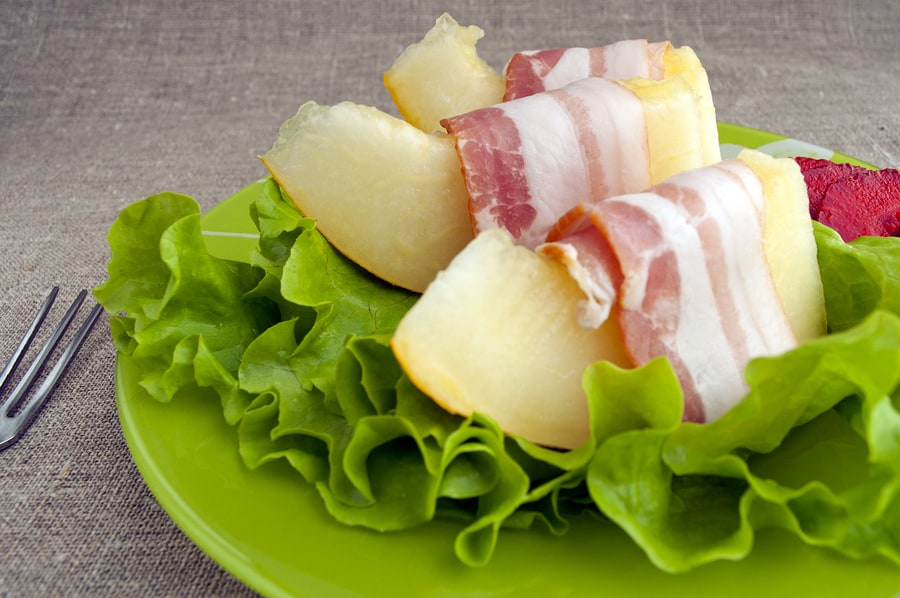
Melon flavor partners
- Melons have a flavor affinity for cilantro, feta, lemon, lime, mint, orange, pecorino, prosciutto, rum, salami, smoked duck, tequila, and yogurt.

Melon nutrition
- Melons are a good source of vitamins A, B, and C and potassium.

Get to know melons
- Melons are tender and trailing annual vines that resemble cucumbers in their habit. They have broad leaves, softly prickled stems, and small yellow flowers with fruit that varies in size from smaller to very large and round or oval. Melon rinds are thick and inedible covering succulent melting flesh and a central cavity filled with flat, oval whitish seeds.
- Melons belong to the same family as cucumber, pumpkin, squash, watermelon, and gourd.
- Melons are thought to have originated in India where they were cultivated in ancient times.
- The ancient Egyptians cultivated melons as long ago as 2,400 B.C. As late as the third century A.D., many melons required spices to make them tasty enough for meals.
- By the fifteenth and sixteenth centuries, hybridization had resulted in consistently delicious melons.
The botanical name for the melon is Cucumis melo. The true cantaloupe is C.m. var. cantaloupesis; the netted or nutmeg muskmelon is C.m. var. cantaloupesis previously recognized as C.m. var. reticulates.
The botanical name for late, winter, or long-season melons including honeydews, casaba melons, and Crenshaw melons is C.m. var. inodorus.
Also of interest:
How to Harvest and Store Melons
How to Harvest and Store Watermelon
Melon articles at Harvest to Table:
How to Plant and Grow Watermelon
How to Harvest and Store Melons
How to Harvest and Store Watermelon
Melons Growing Problems Troubleshooting
Serve Watermelon With These Flavor Matches
Articles of interest:
Best Herbs for Container Growing
Garden Planning Books at Amazon:
- Vegetable Garden Almanac & Planner
- Kitchen Garden Grower’s Guide Vegetable Encyclopedia
- Vegetable Garden Grower’s Guide
- Tomato Grower’s Answer Book
More kitchen tips:
Bring your harvest to the table. Kitchen prep tips and easy recipes for the vegetables you grow. Click below for vegetable prep and recipes you can use now.
- Almonds
- Apples
- Apricot
- Aprium
- Artichoke
- Arugula
- Asparagus
- Avocado
- Bamboo Shoots
- Banana
- Basil
- Beans, Dried
- Beans. Long
- Beans, Shell
- Beans, Snap
- Beets
- Bitter Melon
- Blackberry
- Bok Choy
- Broccoli
- Broccoli Raab
- Brussels Sprouts
- Cabbage
- Cardoon
- Carrots
- Cauliflower
- Celeriac
- Celery
- Chard
- Chayote Squash
- Cherimoya
- Cherries
- Chestnut
- Chickpea
- Chinese Cabbage
- Chives
- Cilantro
- Citron
- Clementine
- Collards
- Coriander
- Corn, Sweet
- Corn, Baby
- Corn Salad, Mache
- Cranberry
- Cress
- Cucumber
- Daikon
- Dandelion
- Dill
- Eggplant
- Endive, Belgian
- Endive and Escarole
- Fava Beans
- Fig
- Florence Fennel
- Garlic
- Ginger
- Grapefruit
- Grapes
- Guava
- Horseradish
- Jerusalem Artichoke
- Jicama
- Jujube
- Kale
- Kiwifruit
- Kohlrabi
- Kumquat
- Leeks
- Lemongrass
- Lemons
- Lettuce
- Lime
- Mache (Corn Salad)
- Mandarin Orange
- Mango
- Maple Syrup
- Marjoram
- Melons
- Michihili
- Mint
- Mizuna
- Mushrooms
- Mushrooms, Cremini
- Mustard Greens
- Napa Cabbage
- Nectarine
- Okra
- Olives
- Olive oil
- Onions
- Oranges
- Oregano
- Parsley
- Parsley Root
- Parsnips
- Passion Fruit
- Pawpaw
- Peaches
- Pears
- Peas, Garden Snap
- Peas, Snow
- Pei Tsai
- Peppers, Chili
- Peppers, Sweet
- Persimmon
- Pineapple
- Pineapple Guava
- Plantain
- Plums
- Pluots
- Pomegranate
- Potatoes
- Prickly Pear
- Pumpkin
- Quince
- Radicchio
- Radishes
- Raspberries
- Rosemary
- Rhubarb
- Rutabaga
- Sage
- Salsify
- Sauerkraut
- Savory
- Shallots
- Sorrel
- Spinach
- Squash, Summer
- Squash, Winter
- Strawberries
- Sunchokes
- Sunflower
- Sweet Potato
- Swiss Chard
- Tangerine
- Taro
- Tarragon
- Thyme
- Tomatillo
- Tomato
- Turnip
- Turnip Greens
- Yams















